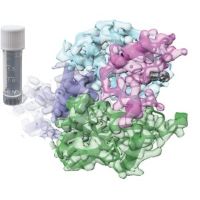Specification
| Description | Recombinant protein from the full-length sequence of homo sapiens DEXD/H-box helicase 58 (DDX58) (NM_014314). |
| Organism | Homo sapiens (Human) |
| Expression Host | Human Cells |
| Tag Info | His or DYKDDDDK. Please contact us if you need further information or require specific designed tag. |
| Purity | Greater than 90% by SDS-PAGE gel |
| Uniprot ID | O95786 |
| Entry Name | DDX58_HUMAN |
| Gene Names | DDX58 |
| Alternative Gene Names | |
| Alternative Protein Names | Antiviral innate immune response receptor RIG-I (DEAD box protein 58) (Probable ATP-dependent RNA helicase DDX58) (EC 3.6.4.13) (RIG-I-like receptor 1) (RLR-1) (Retinoic acid-inducible gene 1 protein) (RIG-1) (Retinoic acid-inducible gene I protein) (RIG-I) |
| Application | Antigens, Western, ELISA and other in vitro binding or in vivo functional assays, and protein-protein interaction studies; For research & development use only! |
| Buffer | Purified protein formulated in a sterile solution of PBS buffer, pH7.2, without any preservatives |
| Endotoxin | Endotoxin level is < 0.1 ng/µg of protein (<1EU /µg) |
| Length | 925 |
| Molecular Weight(Da) | 106600 |
| Protein Sequence | (The sequence of expressed protein may have some variation from the sequence shown below. Please contact us for the exact sequence.) MTTEQRRSLQAFQDYIRKTLDPTYILSYMAPWFREEEVQYIQAEKNNKGPMEAATLFLKFLLELQEEGWFRGFLDALDHAGYSGLYEAIESWDFKKIEKLEEYRLLLKRLQPEFKTRIIPTDIISDLSECLINQECEEILQICSTKGMMAGAEKLVECLLRSDKENWPKTLKLALEKERNKFSELWIVEKGIKDVETEDLEDKMETSDIQIFYQEDPECQNLSENSCPPSEVSDTNLYSPFKPRNYQLELALPAMKGKNTIICAPTGCGKTFVSLLICEHHLKKFPQGQKGKVVFFANQIPVYEQQKSVFSKYFERHGYRVTGISGATAENVPVEQIVENNDIIILTPQILVNNLKKGTIPSLSIFTLMIFDECHNTSKQHPYNMIMFNYLDQKLGGSSGPLPQVIGLTASVGVGDAKNTDEALDYICKLCASLDASVIATVKHNLEELEQVVYKPQKFFRKVESRISDKFKYIIAQLMRDTESLAKRICKDLENLSQIQNREFGTQKYEQWIVTVQKACMVFQMPDKDEESRICKALFLYTSHLRKYNDALIISEHARMKDALDYLKDFFSNVRAAGFDEIEQDLTQRFEEKLQELESVSRDPSNENPKLEDLCFILQEEYHLNPETITILFVKTRALVDALKNWIEGNPKLSFLKPGILTGRGKTNQNTGMTLPAQKCILDAFKASGDHNILIATSVADEGIDIAQCNLVILYEYVGNVIKMIQTRGRGRARGSKCFLLTSNAGVIEKEQINMYKEKMMNDSILRLQTWDEAVFREKILHIQTHEKFIRDSQEKPKPVPDKENKKLLCRKCKALACYTADVRVIEECHYTVLGDAFKECFVSRPHPKPKQFSSFEKRAKIFCARQNCSHDWGIHVKYKTFEIPVIKIESFVVEDIATGVQTLYSKWKDFHFEKIPFDPAEMSK |
Background
| Function | FUNCTION: Innate immune receptor that senses cytoplasmic viral nucleic acids and activates a downstream signaling cascade leading to the production of type I interferons and proinflammatory cytokines. Forms a ribonucleoprotein complex with viral RNAs on which it homooligomerizes to form filaments. The homooligomerization allows the recruitment of RNF135 an E3 ubiquitin-protein ligase that activates and amplifies the RIG-I-mediated antiviral signaling in an RNA length-dependent manner through ubiquitination-dependent and -independent mechanisms (PubMed:28469175, PubMed:31006531). Upon activation, associates with mitochondria antiviral signaling protein (MAVS/IPS1) that activates the IKK-related kinases TBK1 and IKBKE which in turn phosphorylate the interferon regulatory factors IRF3 and IRF7, activating transcription of antiviral immunological genes including the IFN-alpha and IFN-beta interferons (PubMed:28469175, PubMed:31006531). Ligands include 5'-triphosphorylated ssRNAs and dsRNAs but also short dsRNAs (<1 kb in length). In addition to the 5'-triphosphate moiety, blunt-end base pairing at the 5'-end of the RNA is very essential. Overhangs at the non-triphosphorylated end of the dsRNA RNA have no major impact on its activity. A 3'overhang at the 5'triphosphate end decreases and any 5'overhang at the 5' triphosphate end abolishes its activity. Detects both positive and negative strand RNA viruses including members of the families Paramyxoviridae: Human respiratory syncytial virus and measles virus (MeV), Rhabdoviridae: vesicular stomatitis virus (VSV), Orthomyxoviridae: influenza A and B virus, Flaviviridae: Japanese encephalitis virus (JEV), hepatitis C virus (HCV), dengue virus (DENV) and west Nile virus (WNV). It also detects rotaviruses and reoviruses. Detects and binds to SARS-CoV-2 RNAs which is inhibited by m6A RNA modifications (Ref.63). Also involved in antiviral signaling in response to viruses containing a dsDNA genome such as Epstein-Barr virus (EBV). Detects dsRNA produced from non-self dsDNA by RNA polymerase III, such as Epstein-Barr virus-encoded RNAs (EBERs). May play important roles in granulocyte production and differentiation, bacterial phagocytosis and in the regulation of cell migration. {ECO:0000269|PubMed:15208624, ECO:0000269|PubMed:15708988, ECO:0000269|PubMed:16125763, ECO:0000269|PubMed:16127453, ECO:0000269|PubMed:16153868, ECO:0000269|PubMed:17190814, ECO:0000269|PubMed:18636086, ECO:0000269|PubMed:19122199, ECO:0000269|PubMed:19211564, ECO:0000269|PubMed:19576794, ECO:0000269|PubMed:19609254, ECO:0000269|PubMed:19631370, ECO:0000269|PubMed:21742966, ECO:0000269|PubMed:28469175, ECO:0000269|PubMed:29117565, ECO:0000269|PubMed:31006531, ECO:0000269|Ref.63}. |
| Pathway | |
| Protein Families | Helicase family, RLR subfamily |
| Tissue Specificity |
QC Data
| Note | Please contact us for QC Data |
| Product Image (Reference Only) |  |

